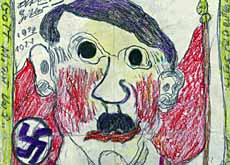Outsider artist obsessed with Hitler

Works by an artist whose obsession with Adolf Hitler led him to portray the Nazi leader dozens of times are being shown in a former Carthusian monastery.
The exhibition also tells the remarkable story of how Theo Wagemann’s pictures came to be shown in a place where monks lived in silence for nearly 400 years.
Born near Aachen in Germany in 1918, Wagemann was himself reduced to a life of virtual silence after suffering a traumatic shock at the age of 13.
He hardly ever spoke again, and his mental condition brought the risk of euthanasia in the political climate of the Third Reich during the 1930s.
But protected by his family, he survived and after being admitted to an institution in 1977, began his prolific output of coloured drawings – including the Hitler portraits.
With no formal art education and lacking rudimentary materials, Wagemann made do with scraps of paper and abandoned pencils. Most of the drawings disappeared, taken away by staff who failed to recognise their quality.
Typical outsider artist
All the pictures would have been lost had it not been for a young trainee, Robert Küppers, who worked at the institution for a brief period in the early 1980s.
Küppers immediately saw that Wagemann had talent, provided him with materials and made sure that over 200 of his drawings were preserved.
The result is now on view in the former monastery in the small Swiss village of Warth in Canton Thurgau.
“Theo was a typical outsider artist,” says Markus Landert, curator of the cantonal art museums which share the monastery with a history museum, concert facilities, a baroque church and a hotel and seminar complex in the tranquil setting of Warth.
Outsider artists tend to be self-taught loners, marginal characters who are patients in psychiatric clinics, prisoners, or simply eccentric and obsessive.
Landert told swissinfo nobody could explain Wagemann’s obsession with Hitler. “It may be a mixture of fear and fascination, but we simply don’t know,” he said.
Disturbing portraits
The museum had thought long and hard about whether the portraits should be included in the exhibition.
But although they can be regarded as disturbing – because of the subject matter – it could also be said that no Wagemann exhibition would be complete without them.
Besides, there are many others on display, including portraits of 20th century German politicians, and the artist’s interests were by no means confined to Hitler.
Wagemann was a devout Catholic whose subject matter also included scenes from the Life of Jesus, as well as coloured drawings of such children’s classics as “Hansel and Gretel”.
The exhibition ends on August 17.
swissinfo, Richard Dawson
Theo Wagemann (1918-1998) was reduced to a life of virtual silence after suffering a major shock at the age of 13. He hardly ever spoke again.
After being admitted to an institution in 1977 he began his prolific output of coloured drawings – including many portraits of Adolf Hitler.
With no formal art education and lacking rudimentary materials, Wagemann was a typical outsider artist.
His drawings are now being exhibited in Canton Thurgau’s fine arts museum, in a former monastery in the village of Warth.

In compliance with the JTI standards
More: SWI swissinfo.ch certified by the Journalism Trust Initiative
You can find an overview of ongoing debates with our journalists here . Please join us!
If you want to start a conversation about a topic raised in this article or want to report factual errors, email us at english@swissinfo.ch.